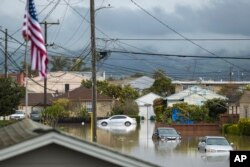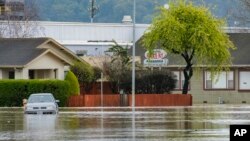Authorities ordered more than 1,500 people to evacuate early Saturday from a Northern California agricultural community famous for its strawberries after the Pajaro River's levee was breached by flooding from a new atmospheric river pummeling the state.
Monterey County officials on Saturday said the break in the levee — upstream from the unincorporated community of Pajaro along California’s Central Coast — is about 30.48 meters wide. Crews had gone door to door Friday afternoon to urge residents to leave before the rains came but some stayed and had to be pulled from floodwaters early Saturday.
First responders and the California National Guard rescued more than 50 people overnight. One video showed a member of the Guard helping a driver out of a car trapped by water up to their waists.
“We were hoping to avoid and prevent this situation, but the worst-case scenario has arrived with the Pajaro River overtopping and levee breaching at about midnight," wrote Luis Alejo, chair of the Monterey County Board of Supervisors, on Twitter.
Alejo called the flooding “massive,” saying it has affected Pajaro's 1,700 residents — many of them Latino farmworkers — and that the damage will take months to repair.
The Pajaro River separates the counties of Santa Cruz and Monterey in the area that flooded Saturday.
Officials had been working along the levee in the hopes of shoring it up when it was breached early Saturday morning. Crews began working to fix the levee around daybreak Saturday as residents slept in evacuation centers.
The Pajaro Valley is a coastal agricultural area known for growing strawberries, apples, cauliflower, broccoli and artichokes. National brands like Driscoll’s Strawberries and Martinelli’s are headquartered in the region.
In 1995, the Pajaro River's levees broke, submerging 2,500 acres (1,011 hectares) of farmland and the community of Pajaro. Two people died and the flooding caused nearly $100 million in damage. A state law that was passed last year advanced state funds for a levee project. It was scheduled to start construction in 2024.
This week's storm marked the state’s 10th atmospheric river of the winter, storms that have brought enormous amounts of rain and snow to the state and helped lessen the drought conditions that had dragged on for three years. State reservoirs that had dipped to strikingly low levels are now well above the average for this time of year, prompting state officials to release water from dams to assist with flood control and make room for even more rain.
State transportation officials said Friday they removed so much snow from the roadways in February that it would be enough to fill the iconic Rose Bowl 100 times.
Democratic Governor Gavin Newsom has declared emergencies in 34 counties in recent weeks, and the Biden administration approved a presidential disaster declaration for some on Friday morning, a move that will bring more federal assistance.
Emergency officials have warned people to stay off roads if they can and to carefully heed flash flood warnings.
The atmospheric river, known as a “Pineapple Express” because it brought warm subtropical moisture across the Pacific from near Hawaii, was melting lower parts of the huge snowpack built in California’s mountains. Snow levels in the Sierra Nevada, which provides about a third of the state’s water supply, are more than 180% of the April 1 average, when it is historically at its peak.
The snowpack at high elevations is so massive it was expected to be able to absorb the rain, but snow below 1,219 meters could start to melt, potentially contributing to flooding, forecasters said.
Lake Oroville — one of the most important reservoirs in the state and home to the nation’s tallest dam — has so much water that officials on Friday opened the dam’s spillways for the first time since April 2019. The reservoir’s water has risen 54.8 meters since December 1. Of the state’s 17 major reservoirs, seven are still below their historical averages this year.
State water managers also were grappling with the best way to use the storms to help emerge from a severe drought. On Friday, Newsom signed an executive order making it easier for farmers and water agencies to use floodwater to refill underground aquifers. Groundwater provides on average about 41% of the state’s supply each year. But many of these underground basins have been overdrawn in recent years.
Forecasters warned that mountain travel could be difficult to impossible during the latest storm. At high elevations, the storm was predicted to dump heavy snow, as much as 2.4 meters over several days.
Yet another atmospheric river is already in the forecast for early next week. State climatologist Michael Anderson said a third appeared to be taking shape over the Pacific and possibly a fourth.
California appeared to be “well on its way to a fourth year of drought” before the early winter series of storms, Anderson said. “We’re in a very different condition now,” he noted.











